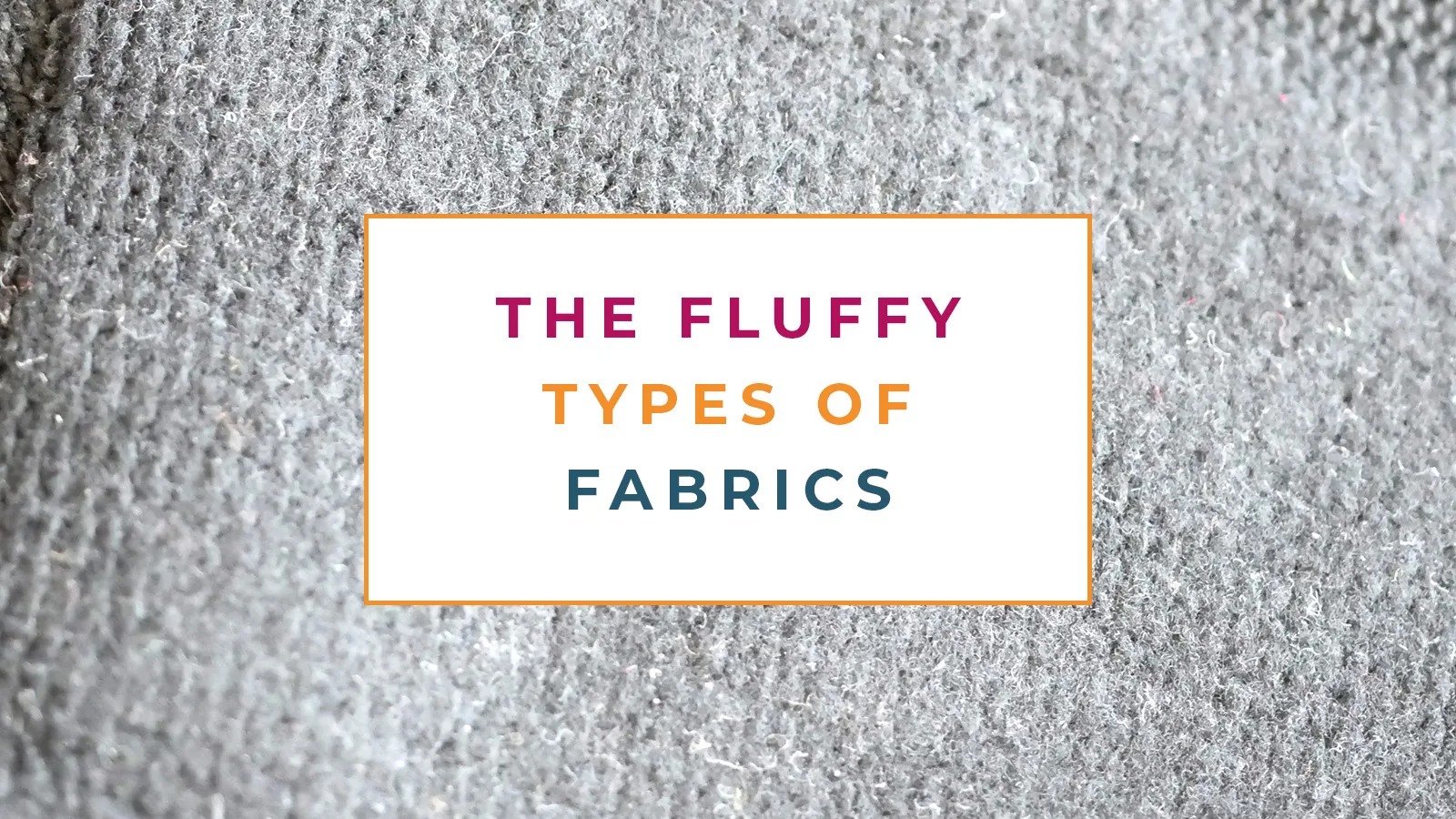Personally, I try to steer clear of fluffy fabrics, because I’m one of those people who get the heebie-jeebies when they touch them. The only types I can handle are faux fur and shearling, and that’s assuming my hand is not rubbing them in the wrong direction.
That said, there are many people who are not as odd as I am, and love a good fluffy fabric, so today I’m going to dive in and explore all the different fluffy fabric types for them – and I promise not to grimace along the way!

Fluffy Fabric Fibers
Fabrics that are fluffy can be made from a variety of fibers. In fact, the fibers are sometimes what causes the fluffiness to happen, though in most cases the fluff aspect is created in the manufacturing process.
Natural fibers that are used to create fluffy fabrics include grown fibers like cotton and animal fibers such as cashmere and shearling. One synthetic fiber that is used the most for creating furry fabrics is polyester.
Fibers that are natural need to be properly processed before becoming fluffy. This process can include carding and spinning, and the resulting fiber is then treated similarly to man-made fibers, being either knitted or woven to create the fluffy texture.
Different Types Of Fluffy Fabric
Now that we’ve covered the fibers that are used to create these cozy fabrics, we can dive into what each of them are and how they’re used in creating clothing.
Alpaca
Alpaca is a natural fiber which is gathered from the fur of alpaca, which is mostly found in South America. Alpaca fiber is well known for being both soft and warm. While it’s rare to see alpaca listed as the sole fiber in fabric, it is a fiber that is often used in combination with other fibers.
After the alpaca fibers are carded and spun, it can be used to create yarn. This yarn can then be woven or knitted – some people even like to felt it! – to create a fabric that will range from lightweight and airy to rather densely fluffy, and can be used for clothing.
Clothing items that alpaca is used for include sweaters and scarves, which will keep us all nice and cozy in the colder winter months!
Angora
Angora is similar to alpaca in that it is a fiber used to create fabrics, rather than being a fluffy type of fabric. It is known to be very soft and warm, gathered from the Angora rabbits, whose fur is made up of very long hairs and even softer fibers underneath. They too can be spun into yarn like alpaca, and then woven or knitted..
You’ll find that sweaters and scarves are again the most commonly used clothing items that feature Angora.
Boucle

Boucle is not a one fiber type of fabric, and technically it may not be considered as a ‘fluffy fabric’ by all who use it. Generally boucle is made up of a combination of fibers, with one yarn being a boucle yarn and other fibers are regular yarns.
Boucle yarn is made during a special process where loops and curls are created in the yarn as it is spun. This boucle yarn is then spun with a smooth core yarn, and this is why it has a textured appearance.
Boucle can be made from any fiber, including:
- Acrylic
- Mohair
- Polyester
- Wool
Generally, boucle is available as 100% polyester or as a poly blend with other fibers.
Cashmere
Another fiber that is known for creating a soft and fluffy fabric, cashmere is gathered from the undercoat of the cashmere goat. I have a very well worn and well loved cashmere scarf that was a gift over 10 years ago, and while it is incredibly soft and warm, it is only fluffy because of the way it was knitted. Are you sensing a theme here? Generally that when natural fibers are turned into knit fabrics they can often result in very fluffy fabrics or just slightly textured fabric types.
Chenille

Chenille has a very distinctive ‘fuzzy’ look to it, and is created by weaving or knitting a base yarn with another yarn that is ‘looped’ to create the raised pile, or ‘fuzzy’ texture. Once the fabric has been woven or knitted, the loops are cut which creates the tufts and makes us want to stroke it. Actually, chenille is one of the fuzzy fabrics that I don’t have an issue with.
Faux Fur


Whether you call it faux fur or fake fur, this is a fabric that can have a long pile or a short pile. It can also have a woven or a knitted backing, with the latter generally costing less. Most faux furs – if not all – are considered to be polyester fabrics, and they are used for warm winter coats because polyester is not known for its breathability and so helps to keep body heat trapped close to us and thus warmer in the winter months.
I created a lovely cropped jacket using white faux fur fabric which was used for the cover of a CD – I really should find that pattern out and make it available for those who would like to make their own faux fur coat.
Felt

Felt is neither woven or knitted, but is instead created by matting and compressing fibers together. This felting process results in a fabric where both sides can be used as right sides. As well as being popular for some garments types, felt is also a popular option for diy craft projects.
Fleece

Polyester fleece fabric is the one fabric that REALLY makes me gnarly. In fact, the past winter I had to touch and sew it, to help my Dad out. He had bought himself a pair of fleece joggers (why m’Pa, why?) and they came about 8″ / 20cm too long. And despite me doing my best to get him in front of a sewing machine, it just wasn’t happening. So I (yay, lucky me!) took them up by that amount and hemmed them for him, cringing the entire time.
Minky
This soft fluffy style material is so named because of its similarity to the fur of a mink. It has a soft hand feel to it, and is generally made from polyester. It’s used a lot for baby blankets and plush toys but has also been used for clothing that calls for plush fabric too.
Mohair
Gathered from the Angora goat (not the aforementioned Angora rabbit!) mohair is another fiber rather than fabric, that is used to create materials that are warm and cozy, and while it is not as soft as other animal fibers covered, it still does result in a good fabric that can be used for coats, sweaters and even suits!
Shearling
Known as shearling leather or shearling wool, this ‘fabric’ has a leather or suede sheepskin on one side and the natural soft sheep’s wool on the other. The natural sheepskin provides a natural barrier against the rain and cold and is a popular material for jackets and coats, footwear and hats.
Sherpa
Made from synthetic fibers – polyester – sherpa fleece fabric can be either knitted or woven and is then ‘napped’ which creates the fuzzy texture. It’s a lot more affordable and easy to care for than shearling which is why it has become so popular, but it is another one that I do not like the feel of.
Velour / Velvet

I’ve combined the two here, because they really are very similar to most people unless you’ve explored the different types of velvet.
Made from natural or man made fibers, this fabric has a directional nap, and should be sewn with care. Velvet is used for many garment types, including dresses, skirts, jackets and more!
3 Tips For Sewing Fluffy Fabrics
Now that you know more about the different types of fluffy fabrics, it seems only fair that I share some tips with you on how to sew them.
- Cutting tool: while I do love a rotary cutter, if you play to sew a fabric that has a pile or nap, make sure to use sharp fabric scissors. There’s nothing worse than faux fur garments that have had the pile cut straight across. Go on, ask me how I know this!
- Pattern weights: I am not against pins or clips, but for fabrics that are not smooth, pattern weights may just be a better fit for you. They will help to keep some fabrics under control more than a pin or clip will, so do give it a try!
- Walking foot: I recommend using a walking foot where possible, more so if the fabric you’ve chosen to sew is ‘thick’ as this will help the sewing machine to sew them without any accidental gathering and tucks, which happens when one fabric layer moves faster or slower than the other.
I hope that this has been helpful for all you fluffy fabric lovers out there. I personally will be going back to my non-fluffy favorites – I’m working with some stunning Italian linen at the moment – but will leave you with this article on the different types of textured fabrics!
